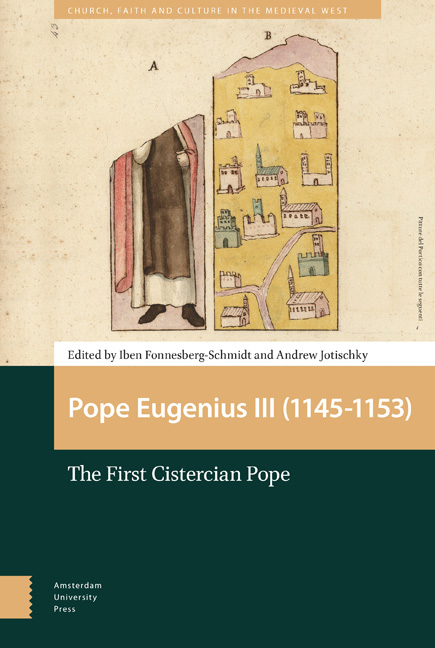Book contents
- Frontmatter
- Contents
- Preface
- Abbreviations
- Maps and Figures
- Introduction
- 1 ‘Justinian’s Laws, not the Lord’s’: Eugenius III and the Learned laws
- 2 Curial Politics and Papal Power : Eugenius III, the Curia, and Contemporary Theological Controversy
- 3 The Cistercians, Eugenius III, and the Disputed York Election
- 4 Eugenius III and the Crusades to the East
- 5 Eugenius III and the Northern Crusade
- 6 The Benefits of Exile
- 7 Eugenius III and France: the Protected Protector
- 8 A Golden Rose and the Deaf Asp that Stoppeth her Ears: Eugenius III and Spain
- 9 Eugenius III and the Roman Commune
- 10 Eugenius III Reclaims the Patrimony of St Peter
- 11 Eugenius III’s Privileges to Cistercian Houses
- 12 Eugenius III at Cîteaux, 1147
- 13 Eugenius III and the Church in the Crusader States
- Index
12 - Eugenius III at Cîteaux, 1147
Published online by Cambridge University Press: 22 December 2020
- Frontmatter
- Contents
- Preface
- Abbreviations
- Maps and Figures
- Introduction
- 1 ‘Justinian’s Laws, not the Lord’s’: Eugenius III and the Learned laws
- 2 Curial Politics and Papal Power : Eugenius III, the Curia, and Contemporary Theological Controversy
- 3 The Cistercians, Eugenius III, and the Disputed York Election
- 4 Eugenius III and the Crusades to the East
- 5 Eugenius III and the Northern Crusade
- 6 The Benefits of Exile
- 7 Eugenius III and France: the Protected Protector
- 8 A Golden Rose and the Deaf Asp that Stoppeth her Ears: Eugenius III and Spain
- 9 Eugenius III and the Roman Commune
- 10 Eugenius III Reclaims the Patrimony of St Peter
- 11 Eugenius III’s Privileges to Cistercian Houses
- 12 Eugenius III at Cîteaux, 1147
- 13 Eugenius III and the Church in the Crusader States
- Index
Summary
Abstract
In September 1147, Eugenius III attended the annual General Chapter meeting of the Cistercian Order at Cîteaux, ‘not only presiding as pope but staying in fraternal love amongst the brothers, as if he was one of them’. This paper investigates what is known of the papal visit and examines the implications for the founders of three religious houses, seeking incorporation into the Order. While Stephen of Obazine and Vitalis of Savigny, together with their followers, were welcomed into the Cistercian family, with ‘Eugenius himself intervening’, the third, Gilbert of Sempringham, was sent away, disconsolate. Yet Gilbert and Bernard of Clairvaux drew up the Gilbertine Rule between 1147 and 1148 and Eugenius himself instituted Gilbert as head of his community.
Keywords: General Chapter; Savigny; Obazine; Gilbertine Rule; Sempringham; incorporation; women
By the mid-twelfth century, the Cistercians had, albeit often reluctantly, begun to assimilate a considerable number of diverse eremitical and semieremitical groups into their growing ranks. At precisely the moment when Eugenius III (1145–53), himself a Cistercian, returned to the Order's mother house in September 1147 to be received with honour, the presence there of three religious who represented a second wave of would-be recruits, pointed to ‘the coalescence around Cîteaux of a remarkably variegated movement of monastic reform, involving numerous independent houses’. Attended by more than three hundred abbots from within the Cistercian family, presided over by Raynard of Cîteaux (1134–50) and accompanied by the charismatic figure of Bernard of Clairvaux (1113–53), the occasion has been described as one of the most important ecclesiastical gatherings of the century. Meanwhile, waiting at the gates of Cîteaux, metaphorically at least, were those who sought incorporation or affiliation for their religious foundations. Stephen of Obazine (c.1085–1154), a cleric from the Bas-Limousin region, had come on behalf of the eponymous male community which he directed between 1130 and 1147, together with its two daughter houses of Bonnaigue and Le Pestre and a further settlement of female followers at Coyroux. Likewise present was Serlo of Vaubadon, third abbot of Savigny (1140–53), supported by Osmund of Beaubec (1127?–56), abbot of the senior male house of the Savigniac family.
- Type
- Chapter
- Information
- Pope Eugenius III (1145–1153)The First Cistercian Pope, pp. 321 - 340Publisher: Amsterdam University PressPrint publication year: 2018



